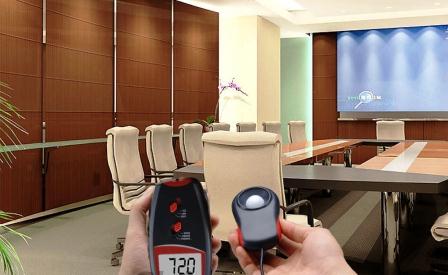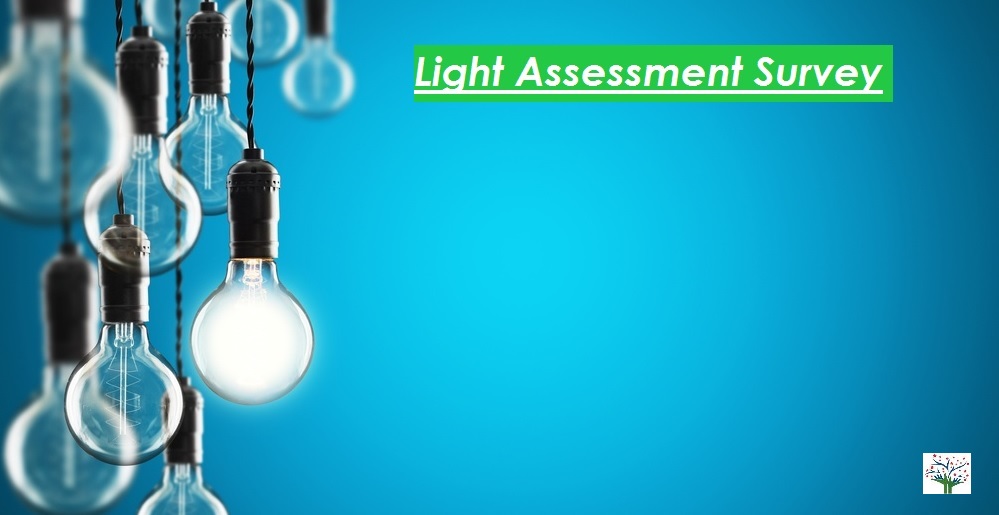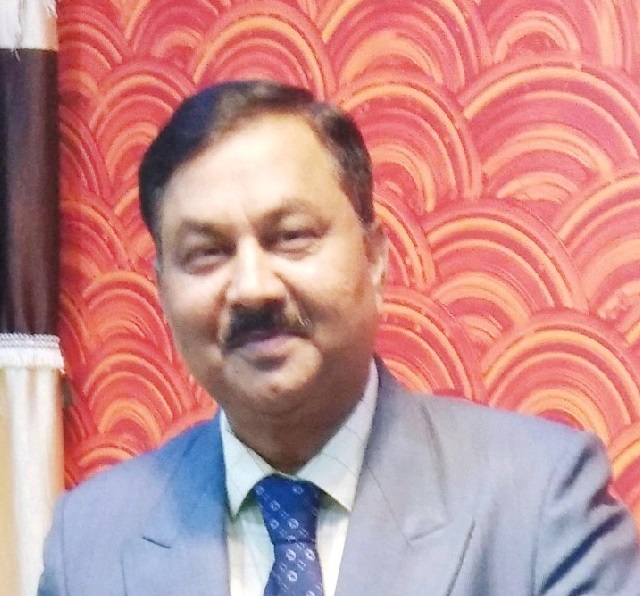Illumination Survey or Light Assessment or LUX Level survey or LUX Monitoring is conducted to identify Too much bright light, glare, low light or flickering light to avoid potential hazards and evaluation of risk to improve employee safety.
Sufficient Lighting has major impact on performance and efficiency of the employees at workplace. It helps them to read labels and safety instructions clearly without any hurdles, to make sure prevention of health hazards of employees.
Therefore there should be appropriate light fall on desk or work area of the employees. Too much bright light (High intensity), Strong glare, Low light, or continuous flickering light are unsuitable for workplace. To ensure good lighting the persons who is accountable for workplace should contact environmental consultants to conduct Illumination Survey or else you can do it on your own by using a lux meter.
Purpose of Illumination Survey
In short purpose to lighting assessment is study of lighting condition in work environment.
- To identify too much bright light, Glare, Low light and flickering light to avoid potential hazards
- Identify who can be harmed
- Evaluation of risks and hazards and suggestion to improvement employee safety
Importance of Illumination in Workplaces
Proper workplace illumination is essential for employee well-being, productivity, and safety. Poor lighting can lead to eye strain, headaches, fatigue, and reduced efficiency. It can also increase the risk of accidents due to visibility issues. Ensuring the right lux levels in different workplace areas helps in maintaining comfort and reducing health risks. Businesses should regularly conduct lighting assessments to comply with workplace safety standards.
Illumination survey or lighting assessment
Illuminance is common parameter while studying Illumination measurement. It defines or measures the amount of light is falling on unit surface area of workplace and its Unit is lux (lx). It is used to evaluate the capability of lighting for seeing an object.
Also Read what is Workplace Monitoring procedure?
Illuminance Measuring Instrument
Illuminance is measured by Lux Meter which is small instrument containing sensor and Display parts. Sensor part is placed on a place where Illuminance to be measured and display part shows reading in Lux unit.
How to Use a Lux Meter for Illumination Testing
To measure light levels accurately, place the lux meter sensor on the work surface where lighting needs to be assessed. Ensure that no external shadows or obstructions are affecting the reading. Record multiple readings from different points and calculate the average lux level. This helps in determining light uniformity across the workspace. For accurate results, take readings at different times of the day and under various lighting conditions.
Illuminance Measurement for General Lighting
In general, uniform light is required in workplace to perform particular type of activity. Eg. Office, reception etc. To measure Illuminance environmental consultants can help.
To measure Illuminance big area should be divided into small equal parts and which can be in square shape. Then sensor of luxmeter or Monitor lighting kit is kept at the centre of each square. By observing results we can come to know about distribution of light in workplace. Also Average of all these values obtained by this method gives average value of illuminance.

Illumination Standards for Different Workplaces
Different workplaces require varying lux levels based on the type of work and environment. For example, offices and conference rooms require 300-500 lux, while factories and production units may need 500-1000 lux. Hospitals, laboratories, and inspection areas demand higher illumination to ensure precision. Following lux level recommendations ensures compliance with occupational health and safety regulations.
Illumination Measurement for an Activity
In some workplaces some task may demand more intensity or brightness than normal. In these type of conditions a local light is installed in area of that task or near that workstation.
To measure Illuminance for a particular task majorly 4 Points are selected on work plane. Their Illuminance is measured for each point in illumination monitoring procedure. Average Illuminance of that task place is calculated by taking average for those 4 values.
Below mentioned points to be taken in consideration while measuring Illuminance for a particular task.
- Illumination at workplace should be taken at work-plane. If there is no work-plane is defined then 3 feet from ground can be considered as work-plane.
- Sensor of luxmeter is to be placed in reading plane where employee do reading tasks. Like desks, or Cupboards (to select books etc.). It means it should be placed horizontally on desk and vertically on cupboard.
- Also it is important that the person who is measuring Illuminance should not obstruct the normal lighting path. He should move sideways, back or forth to ensure that he/she is not blocking light falling on Sensor of luxmeter.
- Always select lowest measurement range in luxmeter as it will give more accurate reading.
- The illumination points should not be too close to obstructions, walls or cupboards.
- While conducting Illumination survey for artificial light make sure that daylight is blocked by curtains. It will give you more accurate reading.
Ready to optimize your lighting setup? Discover how our Lux & Illuminance Calculators can help you find the perfect light for any space!
Key Elements in Illumination Testing
- Light Intensity Measurement: This involves quantifying the amount of light present in a given space using units such as lux or foot-candles. It helps assess whether the lighting levels meet the desired requirements for the specific application.
- Uniformity of Lighting: Evaluating the distribution of light across a space to ensure consistent and even illumination. This helps prevent areas of high or low illumination, which can impact visual comfort and safety.
- Color Rendering: Assessing the ability of lighting to accurately represent colors. Color rendering index (CRI) is commonly used to measure how well a light source reveals the true colors of objects. Higher CRI values indicate better color accuracy.
- Glare Analysis: Evaluating the presence of excessive brightness or discomfort caused by direct or reflected light. Glare can negatively affect visual performance, productivity, and safety. Testing includes measuring glare indexes and identifying potential glare sources.
- Energy Efficiency: Assessing the energy consumption of lighting systems to promote sustainable practices. This involves analyzing lighting design, fixture efficiency, control systems, and exploring options for energy-saving alternatives.
- Compliance with Standards and Regulations: Ensuring that lighting systems adhere to relevant industry standards and guidelines, such as those set by the Illuminating Engineering Society (IES), Occupational Safety and Health Administration (OSHA), or local building codes.
- Lighting Design and Analysis: Conducting comprehensive lighting design evaluations, including analysis of lighting layouts, fixture placement, light distribution, and potential areas for improvement or optimization.
- Outdoor Lighting Assessment: Examining lighting conditions in outdoor environments, such as parking lots, roadways, and recreational areas. This includes factors like visibility, light pollution, safety, and compliance with outdoor lighting standards.
Smart Lighting & Automated Lux Monitoring
With advancements in smart lighting systems, workplaces can now use automated lux monitoring to maintain optimal lighting conditions. Sensor-based lighting adjusts brightness based on natural daylight availability and occupancy, leading to energy savings and improved comfort. AI-driven lux monitoring systems help in real-time data collection and compliance with workplace lighting standards.
What do you mean by Appropriate Level of Illumination or Lighting?
Appropriate level of illumination is the intensity of light which allows you to see what you need to see without any visual discomfort. Illumination is measured in Lux unit.
Read more about Illumination Standards in factory in India
Indian Standards of Lighting of Factories:
In every factory where natural sun light is not reachable or not uniform then in that case additional uniform lighting should be provided. It should avoid hard shadows, strong contrast, free from direct or reflected glare. Role of adequate lighting at workplace plays vital role in employee safety.
Requirement of lighting differs based of type of work & Place. Hence there are two types of lighting requirement based on place and type of work is being carried out.
Recommended Lighting Levels by Maharashtra Factory Rules 1963.
Why Follow Factory Lighting Standards?
Adhering to Factory Act lighting standards ensures that workplaces are safe, comfortable, and compliant with government regulations. Poor lighting in factories, warehouses, and industrial areas can lead to accidents, misreading of labels, and operational inefficiencies. Regular illumination surveys help in identifying under-lit areas and implementing corrective measures.
Read more about Environmental Monitoring at warehouses
Lighting Standards for Places:
| Sr. No. | Area and Work-room. | Minimum intensity of illumination in Lux |
| 1. | Stock-yards, main entrance and exit roads, cat-walks of outdoor plants, coal unloading and storage areas | 20 |
| 2. | Passage-ways, and corridors and stairways, warehouses, stock-rooms for large and bulky materials, platforms of outdoor plants, basements | 50 |
| 3. | Engine and boiler rooms, passengers and freight elevators, conveyers crating and boxing departments, store-rooms and stock-rooms for medium and fine materials, lockers rooms, toilet and wash rooms. | 100 |
Workplace Lighting standards as per Work type:
| Sl. No. | Nature of work | Examples | Minimum intensity if illumination in Lux |
| 1. | Where discrimination of detail is not essential | Handling of material of coarse nature, rough sorting, grinding of clay products, handling coal or ashes. | 50 |
| 2. | Where slight discrimination of detail is essential. | Production of semi-finished iron and steel products, rough assembling, milling of grains, opening, carding, drawing, slubbing, roving, spinning (ordinary) counts of cotton. | 100 |
| 3. | Where moderate discrimination of detail is essential. | Medium assembling, rough bench work and machine work, inspection and testing of products, canning, sawing, venering planning of lumber, sewing of light coloured textiles and leather products, weaving light thread, warping, slashing doubling (fancy) spinning fine counts. | 200 |
| 4. | Where close discrimination of detail is essential. | Medium bench and machine work fine testing, flour grading, leather finishing, weaving cotton goods, or light coloured woollen goods, welding sub-assembly, drilling, rivetting, book- binding and folding. | 300 |
| 5. | Where discrimination of fine detail is involved under a fair degree of contract for long periods of time. | Fine assembling, fine bench and machine work, fine inspection, fine polishing and bevelling of glass, fine wood working, weaving dark coloured woollen goods. | 500 |
| 6. | Where discrimination of extremely fine detail is involved under conditions of extremely poor contrast for long periods of time. | Extra fine assembling, extra fine inspection, testing of extra fine instruments, jewellery and watch manufacturing, grading and working of tobacco products, dark cloth hand tailoring, final perching in dye works, make-up and proof reading in printing plants. | 1000 |
Illumination Testing Services
Illumination Survey or Lighting Assessment is very important factor to find out health hazards, it can give idea what are blind spots in workplace, how to overcome them, where to put light sources to get best out of them etc. If this process followed correctly then it will help to increase efficiency and performance of Employees.

We suggest you to that above mentioned concepts are very basic in nature for illumination measurement. An illumination measurement professional may or may not follow these instructions as per his personal judgement or experience.
LUX Monitoring Service
Lux monitoring refers to the measurement and tracking of light intensity in a given area, typically expressed in lux, the unit of illuminance. This process is essential for maintaining optimal lighting conditions in various environments, such as workplaces, hospitals, retail spaces, and outdoor areas. Proper lux levels enhance productivity, safety, and comfort by ensuring adequate lighting for tasks and reducing glare or excessive brightness. Lux monitoring systems, often equipped with sensors, enable real-time adjustments, energy savings, and compliance with lighting standards, making them crucial for both human well-being and environmental sustainability.
To know more about Environmental Monitoring and assessment services
Also you can refer Noise Impact Assessment to know more about Measurement of noise level for new project
We Perfect Pollucon Services is Environmental consultancy firm and offers services in Illumination Survey and Workplace Monitoring.
If you want to know more about our services then contact us by filling up Contact us form present on right side.
Also read more about Illumination Monitoring at workplace
Illumination Survey Calculators – for fun:
1. Lux Level Calculator
📌 Purpose:
The Lux Level Calculator helps determine how many light fixtures are needed to achieve the desired illumination in a given area. This is useful for factories, offices, warehouses, and commercial spaces where proper lighting is essential for safety and productivity.
🧮 Formula:
Number of Fixtures = (Room Area × Required Lux Level) ÷ Luminous Flux per Fixture
Lux Level Calculator
Calculate the required number of light fixtures.
2. Luminous Flux Calculator
📌 Purpose:
This Luminous Flux Calculator helps convert Lux to Lumens, allowing users to determine the total light output required for a specific area. It is helpful for ensuring adequate brightness levels in work environments.
🧮 Formula:
Lumens = Illuminance (Lux) × Surface Area (sq.m)
Luminous Flux Calculator
Convert Lux to Lumens.
3. Energy Savings Calculator for Lighting
📌 Purpose:
This Energy Savings Calculator estimates the amount of money saved when switching from traditional lighting (such as incandescent or fluorescent bulbs) to energy-efficient LED lighting. It helps businesses and homeowners understand their long-term cost savings.
🧮 Formula:
Annual Savings (Rs.) = (Old Wattage – New Wattage) × Hours Per Day × 365 × Cost Per kWh ÷ 1000
Energy Savings Calculator
Estimate your savings when switching to LED lighting.
✅ Reviewed by Our Expert Leadership Team
This service offering is created and reviewed by our senior team of environmental professionals with 10–40 years of experience in pollution control, regulatory compliance, and monitoring services.

Tanaji S. Gajare
Founder & Chairman
40+ years in air & water monitoring, sustainability leadership

Anil Shelke
Executive Director
30+ years in compliance, audits, and ETP/STP operations

Kunal Gajare
Environmental Engineer
10+ years in stack monitoring, MPCB/MoEF clearances, EIA
An illumination report documents the lighting conditions of a workplace, including lux levels, uniformity, and compliance with safety standards. It is used for workplace audits and regulatory compliance.
Illumination assessment is the evaluation of light intensity, distribution, and glare in a workspace. It ensures that lighting meets safety and efficiency requirements.
The normal range of illumination varies by environment. For example, offices require 300-500 lux, while factories may need 500-1000 lux.
Illumination is measured using a lux meter, which records the light intensity (lux) at different points in a workspace.
An illumination test determines whether lighting levels are adequate for a specific environment. It checks for brightness, uniformity, glare, and color rendering.
To conduct an illumination test, place the lux meter sensor on the work surface, take multiple readings, and compare them with recommended lux levels.
Poor illumination can cause eye strain, fatigue, accidents, and decreased productivity. It can also lead to occupational health hazards in high-risk environments.
The recommended lux range for office lighting is 300-500 lux, depending on the tasks being performed.
According to the Factory Act 1948, workplaces must maintain at least 50-1000 lux, depending on the type of work.
Illumination is calculated using the formula:
Illuminance (Lux) = Luminous Flux (Lumens) ÷ Area (m²).

